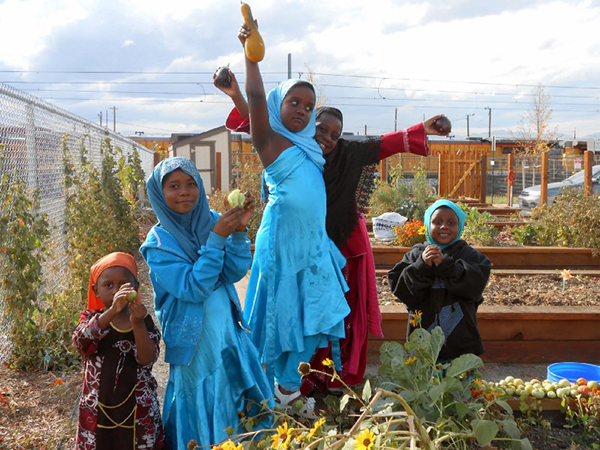Example #1: America’s "Worst City for Walking" Gets Back on its Feet

Oklahoma City—which was named as the “worst US walking city” in a 2008 study of 500 communities by Prevention magazine and the American Podiatric Medical Association—is embarking on big plans to become more walkable. An ambitious $18-million sidewalk improvement fund was approved by voters as part of a tax increase that also included money for parks, transit, bike trails and senior wellness centers around town. Four busy streets heading into downtown are now being narrowed, with new “smart intersections” that provide walkers more safety with “refuge island” medians in the middle of streets and clearly marked crosswalks. Read the story.
Example #2: Columbia Parc at the Bayou District-New Orleans, LA: Holistic Redevelopment to Bring Lasting Change to a Distressed Neighborhood

Learn how social determinants of health are being addressed to build healthier lives, where mixed income housing, new schools, and a sustaining economic anchor completely transformed a once-struggling neighborhood in post-Katrina New Orleans in this Community Close-Up from the Building Healthy Places Network.
Example #3: A Holistic Approach to Community Development in Minneapolis-St. Paul
Learn how community developers are impacting the health of residents in a low-income housing complex in St. Paul and a senior center in Minneapolis, through two Local Initiatives Support Corporation (LISC)-supported projects.
Example #4: The Austin Neighborhood Planning Process
Thanks to Mark Walters, Principal Planner in the Austin Neighborhood Planning and Zoning Department, for explaining the Austin Neighborhood Planning Process.
In 1996, as part of its Austin Tomorrow Comprehensive Plan, Austin, Texas instituted a Neighborhood Planning Process, designed to manage the city’s rapid growth and keep neighborhoods livable. The city was divided into approximately 60 neighborhoods, many of which were combined with others for planning purposes in 2002.
Neighborhood plans are developed by neighborhood stakeholders working with staff from the city’s Neighborhood Planning and Zoning office. Since the city’s resources aren’t great enough to engage all neighborhoods in planning at once, neighborhoods are targeted for planning based on Neighborhood Planning staff analysis of their current or projected need for it. Factors used to prioritize neighborhoods include (but aren’t limited to) projected growth, current problems, and need for services.
NPP starts the planning process in a particular neighborhood with a neighborhood survey mailed to every household, business, and other property owner in the planning area. The survey is a general one relating to perceptions of the neighborhood, its strengths and challenges, and stakeholders’ ideas for its future. Surveys are mailed or e-mailed to the Neighborhood Planning office and tabulated, and the survey is then followed by a community meeting to which all neighborhood stakeholders are invited (again, by direct mail to all stakeholders).
At this meeting, the results of the survey are presented, along with a profile of the neighborhood (demographic, geographic, and land use information) and an explanation of the neighborhood planning process. Participants ask questions and comment about the process and about issues of concern to them. A SOC (Strengths, Opportunities, Challenges) exercise is conducted, and the results of that and the survey are used as a basis for continuing discussions.
The initial meeting gives everyone a chance to understand how neighborhood planning works, and to decide what parts of the process they want to put their energy into. Smaller, follow-up meetings focus on specific areas of planning – vision and goals, land use, transportation, quality of life. Members of each of these tightly focused groups are recruited from those who expressed interest in each of the areas in question. Out of these groups come the goals and objectives for each element in the plan, and the specific recommendations relating to each goal and objective – in other words, the substance of the plan itself.
Neighborhood Planning staff convene and work with these groups, explaining the realities of the city’s capacity and budget, conducting research on zoning and bringing in staff from other city departments to inform the neighborhood about existing capital projects and work plans for the area, and to discuss the feasibility of stakeholders’ suggestions and recommendations, which are then reviewed by the departments themselves. Recommendations that are not deemed feasible or affordable, or are set aside for more study by the city, are nonetheless included in the appendix to the plan, with the reasons why they weren’t approved. The involvement of the relevant city departments throughout the process means that the final plan is realistic, and has already been approved by the departments that will need to do the work of its recommendations.
One aspect of the planning process is a services forum, which convenes representatives of city services departments (transportation, Code Enforcement, etc.) to explain what they do and how they serve the area, and to address stakeholders’ concerns.
Once all the specific-issues groups have finished meeting, the Neighborhood Planning staff prepares an online final survey (distributed by mail to those who don’t have Internet access) that includes a draft of the plan and asks for comments. The staff then makes final adjustments to the plan based on these comments, and calls a final meeting, before which the plan is distributed online (and again, by mail to those who request it). At the meeting, neighborhood stakeholders have one last opportunity to comment on the plan through the final survey, and to approve the final version.
The plan then goes to the Planning Commission (a nine-member appointed body), which reviews it and makes any necessary modifications – usually to land use provisions (i.e., zoning). The Commission then passes the plan on to the City Council with a recommendation for approval or rejection. (At this writing, all submitted plans have been recommended for approval.) The City Council generally accepts the Commission’s recommendation as is.
For the plan to go into effect, the City Council – which has the sole power to make zoning changes – must approve it as an amendment to the city’s Ausin Tomorrow Comprehensive Plan. A hearing accompanies the approval process, and usually results in the plan being adopted as a whole, except for any contested sections (almost always zoning changes being contested by those whose property is affected). These contested sections are settled on a case-by-case basis over time by the City Council.
How smoothly the approval hearing goes depends to a certain extent on the smoothness of the planning process up to that time. Some hearings take an hour or less; others may go till the wee hours of the morning.
Once a plan is approved, it can’t be changed for a year, although it can be amended at any time at the request of the Neighborhood Planning Team. A Neighborhood Planning Team/Neighborhood Contact Team – usually self-selected, and often composed of people with zoning interests and leaders of neighborhood associations and the like – acts as liaison between the Neighborhood Planning staff and the community on issues having to do with the plan.
Neighborhood Planning suggests that plans be revisited, revised, and reapproved every five years to assure that they’re addressing the current and real needs of the neighborhood.
Example #5: A Ride to Better Health
The Mariposa project is on the front lines of a rapidly growing movement seeking to reconnect low-income residents to the critical networks — transit, affordable housing, jobs — that are the cornerstones of opportunity. By centering development efforts around a transit stop, planners are hoping to reinvigorate a neighborhood by connecting its residents to integral supports and services, from hospitals to schools to grocery stores , all while paying heed to the risks of gentrification and displacement.




